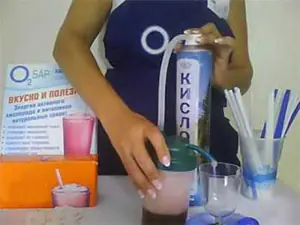The oxygen cocktail is not very popular among athletes and fitness enthusiasts. Almost all attention - both amateurs and professionals - is paid to sports supplements, such as protein powders, gainers, creatine, amino acids, etc. Protein powders supply the tired body of an athlete with the right amount of protein and vitamins. Creatine helps an athlete develop strength and endurance. Amino acids promote metabolism and support the athlete's immunity. An oxygen cocktail in comparison with these products is something insignificant, low in calories and not very tasty.
Of course, such a drink will not help a powerlifter improve his results in squats and bench presses. It will also not help a bodybuilder gain muscle mass faster. Ordinary gym regulars who want to correct problem areas or get rid of excess fat will also not receive much benefit from it.
In fact, there is a benefit from this product, but the consequence of this benefit is not an increase in strength and mass, but an increase in performance. Maintaining the tone of the lungs and cardiovascular system is another “minor” (unfortunately, for many athletes this factor is actually practically insignificant) property of the oxygen cocktail.
Constant consumption of such drinks increases the human body's resistance to oxygen deficiency. As a result, performance increases, which, of course, has a beneficial effect on the overall tolerance of the training, which in turn plays a significant role in the overall physical activity of the athlete.
During heavy physical activity, the body expends a large supply of ATP and oxygen. These two components are interconnected with each other not only organically, but also practically. The process of replenishing ATP reserves depends on the level of oxygen-free oxidation. Simply put, increased oxygen demand negatively affects recovery processes. To speed up this process, it is enough to take a small portion of additional oxygen after training.
It is best if this source is in the form of a liquid, with the necessary dose of vitamins and nutrients involved in the processes of metabolism and anabolism. They are sold in many fitness clubs at relatively inexpensive prices. It is enough to take 250-300 grams of the drink after training. Drinking it before training won't hurt, but it won't be beneficial either. Those athletic “gurus” who strongly advise drinking “oxygen” half an hour before training either do not know what to advise their players, or simply want to make more money from it. Taking an additional source of oxygen before exercise will not help the body produce increased levels of oxygen during exercise.
Aerobic strength training (several exercises for each muscle group, in a large number of approaches and repetitions, or 3-4 series, including one approach in a high number of repetitions for each muscle group) does not exhaust the muscles and tendons to the limit, but the heart and the lungs are subject to stress under this regime. This stress is expressed in a feeling of lack of air, which some gym instructors attribute to insufficient ventilation of the room. In fact, the reason for this lack of air is not at all due to poor ventilation of the hall, but rather due to the increased need of the cardiovascular system for oxygen. A poorly ventilated room only aggravates the situation, but is not its main cause.
Bodybuilders training to tone their muscles should also consume an additional source of oxygen after training. For such purposes, you can consume cocktails during training, but in moderate doses and as needed. In general, athletes are not recommended to drink during training; this can lead to swelling of the stomach and side effects in the gastrointestinal tract.
Powerlifters and weightlifters can also afford to drink drinks during training, but only when they are not yet close to their best results. Consuming liquid (even if it is the most effective gainer) during training, at best, will not lead to anything good, and at worst, it will cause discomfort to the athlete. These unpleasant sensations may not cause much harm to the athlete’s health, but his health will not suffer at all if he categorically forbids himself to drink during high-intensity training.
Making “oxygen” at home is as easy as shelling pears. For this you need: a cylinder with medical oxygen, a mixer, egg white and juice. Almost any juice can be used; the main thing is that it is without pulp. Also, under no circumstances should you use lemonade instead of juice. The gas contained in a carbonated drink and the pulp present in some types of juice interfere with the formation of foam. If there is no juice, you can use milk, fruit juice, or plain water.
You can use licorice root syrup instead of egg white. Experts categorically do not recommend overdoing the dose of this syrup: it contains alcohol. Those who do not like eggs and licorice root can choose other ingredients, which are abundant in any grocery store.
All these components need to be placed in a container (a glass or a simple plastic glass) and, after supplying oxygen from a cylinder into the container, beat in a mixer until a foamy cap forms.
It is advisable to consume an oxygen cocktail on the day of training and for 24 hours after it. The recommended dose is 250-300 g. You can do it more often and in larger doses, but this will not give the athlete’s body even greater benefits.
Among amateur athletes, there is an opinion that all these sports supplements and gainers develop an organic dependence, which reduces the body’s ability to reproduce nutrients and adapt to training stress. These are just speculations generated by amateurs, of whom there are quite a few among regulars of fitness centers and commercial trainers.
The same can be said about oxygen cocktails. These drinks are very beneficial for the health of athletes, although they do not play a significant role in achieving serious results.
Post Views: 243


